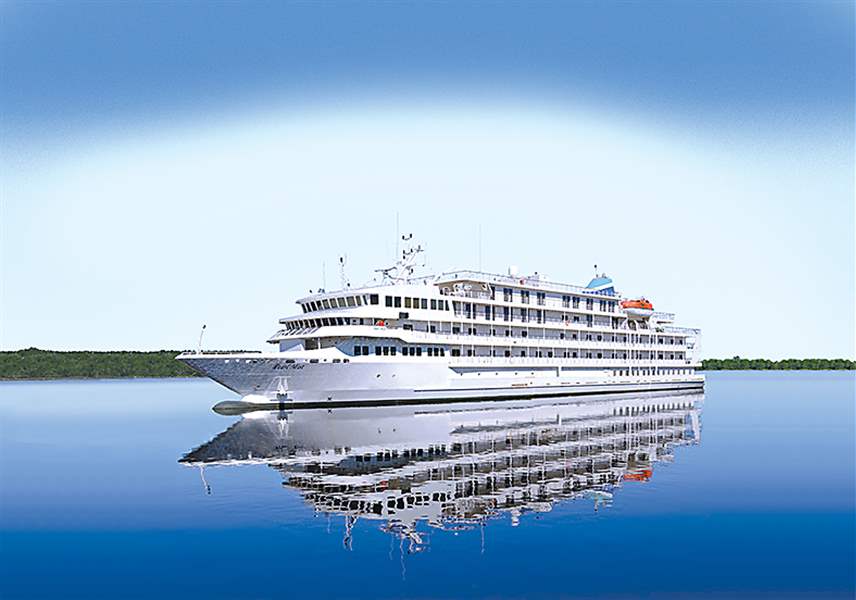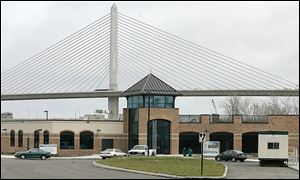
Port Authority board hears cruise pitch
Presentation outlines the merits of being Great Lakes port of call
11/26/2013
The Pearl Mist, depicted in a sketch, is the ship that will be used for Great Lake cruises with the Pearl Seas Cruise Line in 2014.

The Pearl Mist, depicted in a sketch, is the ship that will be used for Great Lake cruises with the Pearl Seas Cruise Line in 2014.
The executive director of the Great Lakes Cruising Coalition made good on a promise he made in October to visit Toledo and talk about how the city could position itself to be a port of call for a future Great Lakes cruise.
Stephen Burnett’s pitch on Tuesday to rejoin the coalition was made to 11 people inside the Toledo-Lucas County Port Authority offices, four of them port board members and one of them Paul Toth, Toledo-Lucas County Port Authority president and chief executive officer.
“We were a founding member, and we paid dues for nine years,” Mr. Toth told him.
The coalition exists to help its member communities become more attractive to cruise lines when they select ports of call.
Mr. Toth invited Mr. Burnett after The Blade published an article on Sept. 29 that stated the port authority had dropped out of the coalition as a budget-cutting move during the nation’s 2008 financial crisis.
Even now, Toledo’s dues would only be $3,750 a year — a fraction of the port authority’s multimillion-dollar operating budget and its $283,000 marketing budget — but Mr. Toth has said the agency was looking for places to cut because of the sour economy.
Port authority revenue declined more than $3.7 million annually between 2007 and 2013. That has reduced the port authority’s budget by 35 percent, which caused 25 staff positions to be eliminated — including 13 in airport operations this year, Mr. Toth said in his invitation.
Mr. Burnett said there are signs the industry is now experiencing a comeback.

A terminal along the Maumee River is owned by the Toledo-Lucas County Port Authority in Toledo’s Marina District. It was built in 2007 and designed to accommodate Great Lakes cruise services such as the Pearl Seas Cruise Line.
No vote was taken, but those who heard Tuesday’s presentation seemed impressed by the possibilities. Mr. Burnett fielded several questions about how the cruise industry, with help from his group, coordinates trips at and between U.S. and Canadian ports. In some cases, the ships rent kayaks or bicycles to accommodate younger travelers, Mr. Burnett told them.
“I think it’s something we really need to take a hard look at,” Jerry Chabler, one of the port board members in attendance said after the meeting. “I felt a lot better about it. I think it’s something we need to pursue.”
Mr. Chabler said he expects the full board to consider rejoining the coalition at its December meeting.
Mr. Burnett, who drove about eight hours from his office in Kingston, Ont., gave an overview on Great Lakes cruising history and his perception of market trends that have infused new life into it. Six small cruise ships are expected to ply Great Lakes water next summer, marketed as luxury cruises to tourists in North America and abroad. Many of the tourists are expected to be from Europe, he said.
Great Lakes cruises usually take 100 to 400 people, with an average cost of $5,000 per person for a nine-day cruise. They are smaller and less expensive than Caribbean cruises, which may have 1,000 passengers, but they offer a mix of different sight-seeing opportunities — from moose to museums. They offer a slice of North America’s heartland, a taste of its big cities, and the allure of some small, charming towns, he said.
“We have nothing to be ashamed of. We have an excellent cruise product in the Great Lakes. It’s refreshing. It’s invigorating,” Mr. Burnett said.
When the Great Lakes had nine cruises about a decade ago, they were credited for generating an estimated $36.8 million for the region’s economy, he said.
During his presentation, Mr. Burnett laid out three examples of day-long side trips Toledo could offer if it ever became a port of call.
They included various combinations of shuttling tourists to sites such as the Toledo Museum of Art, Tony Packos, the Valentine Theatre, the Libbey Glass factory outlet, the Hollywood Casino, Real Seafood, Mancy's, and to a Toledo Mud Hens game at Fifth Third Field.
The packages would ideally be themed. One theme could be about architecture and include a visit to the Our Lady Queen of the Most Holy Rosary Cathedral in Toledo’s Old West End. The cathedral has a five-star rating on tripadvisor.com.
Another trip could emphasize history, with a trip to Fort Meigs, LaRoe’s restaurant in Grand Rapids, the remnants of the Miami and Erie Canal inside Providence Metropark, and the Ludwig Mill.
Officials would want to strike a balance between new development, shopping, historic, and outdoorsy themes, each of which draw different tourists, Mr. Burnett said.
He said the historic theme should not be overlooked. “Giving foreign visitors a window into why people came here and settled is extremely important,” he said.
Casinos, on the other hand, aren’t as important to some Europeans because many have access to them in their homeland. Europeans tend to be “sports crazy,” though, he said, and probably would get excited about a Mud Hens game if it doesn’t go too late into the night and conflict with the time they need to be back on their cruises, Mr. Burnett said.
He said Toledo should aggressively promote itself as a potential port of call to existing cruises now to better position itself for future cruises. The cruise industry tends to flock to established ports “like lemmings,” he said.
Toledo has not hosted cruise passengers for years.
Detroit has been “one of the hardest sells we’ve had,” Mr. Burnett said, alluding to the city’s reputation. But he said cruise passengers who have stopped there, especially from other countries, often remark how much they enjoyed it after seeing sights such as the Motown Museum, the Henry Ford Museum, Greenfield Village, Greektown, and the Detroit Institute of Arts.
“Detroit really, really delivers,” Mr. Burnett said. “As a destination for a short visit, they really have it.”
Incoming Toledo Mayor D. Michael Collins and outgoing Mayor Mike Bell have both said they support the general concept of marketing Toledo to the cruise industry.
Both have said they believe the Maumee River waterfront near downtown will play a key role if the city is to ever achieve the economic prosperity some envision.
Contact Tom Henry at: thenry@theblade.com or 419-724-6079.